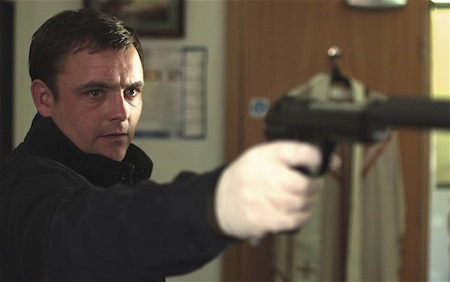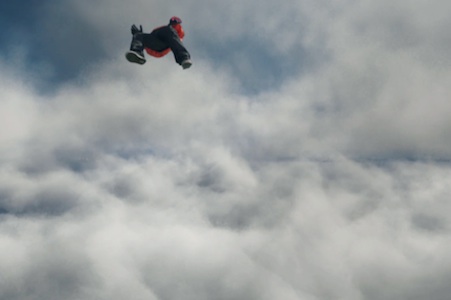The following shots are all from films that I saw for the first time in 2012 and which have stayed in my mind: if I’ve favored long takes over split-second compositions, it’s probably a matter of taste although I think there’s always something to be said for those filmmakers who can collapse an entire feature’s worth of visual and narrative drama into a single camera movement.
1. The near mid-air collision in Chronicle
Only one American genre film showed me something that I simply hadn’t seen before in 2012, and it wasn’t The Avengers, The Dark Knight Rises nor Skyfall (though the latter is overall the best-looking big budget movie in a long time, with all credit due to DP Roger Deakins). No, the thriller with the most striking imagery was Josh Trank’s Chronicle, which hot-wired its tired found-footage conceit by daring to raise the stakes. In the scene in question, it elevated them to about 35,000 feet: newly endowed with telekinetic powers after an encounter with downed meteorite, high schoolers Andrew (Dane De Haan), Alex (Matt Garetty) and Steve (Michael B. Jordan) take a game of touch football into the skies. The idea is that the characters are videotaping their turbo-charged adventures for posterity (think of Brian De Palma circa The Fury directing an episode of Jackass) and while the script (by Max Landis) doesn’t quite sustain their motivations for keeping the camera running, this airborne interlude works so well as a visual metaphor for adolescent high-spiritedness—and for the Icarus-like perils of wanting too much too fast—that the contrivance is forgiven. What’s really breathtaking, though, especially on the big screen, is when the plausibly grubby, wind-whipped DV atmosphere of Matthew Jensens’ cinematography is punctured by the sudden emergence through the clouds of a passenger jet—a genuinely startling intrusion that doesn’t just come out of nowhere for the characters but also appears to be an unprecedented visual gag. The guys fall back to Earth soon thereafter, and so for the most part does the movie, but no one shot in 2012 delivered a comparably weightless thrill.
2. Emilio waits in the car in Greatest Hits
The passenger-seat perspective shot has been a staple of art cinema since Abbas Kiarostami‘s A Taste of Cherry (1997), but it’s hard to remember a film getting better mileage out of a scene shot in a car than Nico Pereda’s Greatest Hits. A valedictory companion piece to his previous movies starring Teresa Sanchez and Gabino Rodriguez—perennially cast as mother and daughter in a series of slightly altered scenarios—Greatest Hits changes things up adding a father to the equation: Emilio (Jose Rodriguez), whose return after many years away throws the household into disarray. Seemingly bent on reconciliation, he drives his family out to Zempoala in the Mexican countryside, an idyllic locale we only ever see through the car’s window. After getting out to walk around, Emilio takes a mysterious phone call compelling him back to the city. He gets back behind the wheel, sitting anxiously in the foreground while his loved ones wander in the far distance. He tells them they can have five minutes, a ludicrously short period of time for an out-of-town family outing. Yet inside of Pereda’s static frame, it feels like a miniature eternity, its grueling duration playing out across the face of a man who seems to be living in a sort of emotional trap. Pereda’s films have been growing increasingly technically accomplished, but this shot is one of the Toronto-based director’s greatest achievements to date: a plausible lifetime of distance, loneliness, evasion and regret distilled into six deceptively placid minutes.

3. Jay brings the hammer down in Kill List
Alfred Hitchcock talked about playing the audience like a piano; Ben Wheatley might see fit to compare his viewers to the heavy bag at a boxing gym. His acclaimed horror-flick whatsit Kill List gains much of its power from its nauseous handheld style and jagged, unpredictable editing, so the rare occasions when the camera holds still command our full attention. At which point Wheatley, who is the most exciting British filmmaker to emerge in some time, is free to hit us over the head. Which he does most brutally in the midpoint money shot where anguished hitman Jay (Neil Maskell) takes a claw hammer to the brain of a bizarrely grateful librarian (Mark Kempner). After some punishing insert shots of other body parts getting brutalized, the camera decamps to a safe distance while Jay readies his tool. Even as he lifts it into the air, we think that there will be a cut, even if it’s to emphasize the impending gore effect work. But Wheatley, who says that he was influenced stylistically by viral videos, plays things out in real time, leading us to wonder both how he did it (that’s really Kempner sitting there in the chair) and also why we’re not looking away. Or, if we are looking away, whether it’ll ever be safe to look at the screen again.
4. Freddie approaches the boat in The Master
Appropriately enough for a movie about a man trying to reconcile his mysterious and all-consuming desires, The Master plays provocatively with focus: at several points in Paul Thomas Anderson’s magisterial sixth feature, the image seems to waver and blur in accordance with the emotions of its protagonist, Freddie Quell (Joaquin Phoenix). These blurs are all the more noticeable because of Anderson’s choice of the 70mm format, which otherwise inscribes an almost uncanny sense of detail, even in hugely scaled compositions. This dichotomy between pitiless clarity and woozy subjectivity plays out spectacularly in the long take where Freddie first spots the man who will become his mentor (and his master), Lancaster Dodd (Philip Seymour Hoffman); he’s a tiny illuminated figure on the deck of a yacht about to cast off from the harbour that our hero—on the run from some migrant workers who think he’s fatally poisoned one of their friends—is approaching on the dead run. Cinematographer Mihai Malaimare, Jr. employs a seemingly bottomless depth of field which creates a feeling that the onboard revelry is within Freddie’s reach even though they’re hundreds of yards away; the effect is of being in two places at once, a sort of out-of-body experience. The sense of distance is then literally collapsed as Freddie rushes down to the water and agilely hops on board as the vessel—lit up like a Christmas tree against a jet-black nighttime—slowly pulls away. Anderson’s Ophuls-meets-Scorsese virtuosity with the Steadicam in his early films is the stuff of legend, but this comparatively simple set-up may be the most concisely suggestive shot of his career. Not only does it bring together the film’s two main characters without having a word pass between them, it also works as a precis of Freddie’s yearning for a safe haven outside of regular society and a rather broad visual joke on the idea that this “able-bodied sailor” is, in more ways than one, heading out to sea.
5. Derek listens to “No Games” in Tower
Well-reviewed in Locarno and at TIFF, Kazik Radwanski’s debut feature has one of the year’s most unusual lead performances from Canadian actor Derek Boogard, whose embodiment of an aspiring computer animator (also named Derek) clumsily navigating his early thirties feels more private than most movie acting. Stalking around his parents’ basement, he seems at once feeble and restless, and when he turns on a YouTube video of R&B artist Serani’s club hit “No Games” the effect is initially comic: the incongruity of a pasty white guy fixating on a dancehall track. But as the song goes on, Derek starts pacing and dancing to the song, bobbing and weaving to the circular melody in a kind of trance that suggests either rigorous control or euphoric release. (It would not be out of line to suggest that one of the models for this scene is the end of Claire Denis’ Beau Travail). It’s a moment that will make some viewers feel very close to him and move others even further away, but the way Radwanski holds the camera so close (a trademark also in his short films) and for such a relatively long time (about two minutes) transcends strangeness or mortification. Something has been captured here, not only of a character whose motives remain clouded throughout, but also of an actor who none of us have had reason to see before, both of whom cut a memorable figure.




